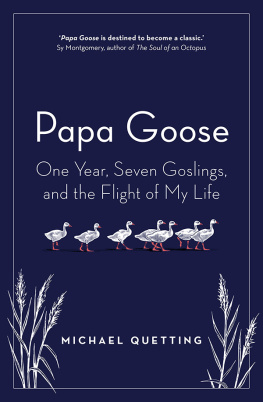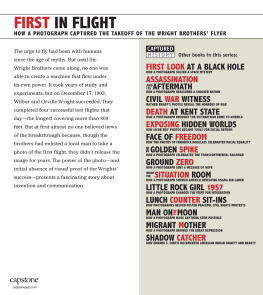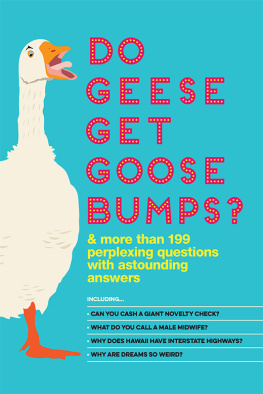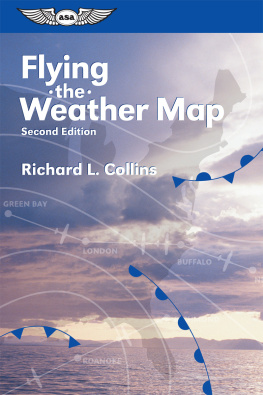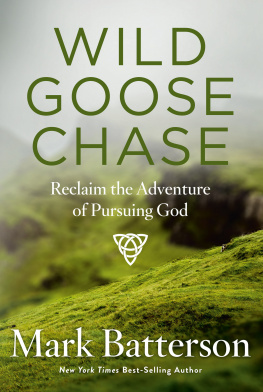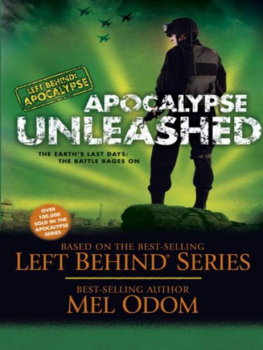Advance Praise for Papa Goose by Michael Quetting
Papa Goose is destined to become a classic. This book has everything in it I love: great animals beautifully portrayed as individuals; cool science; drama, discovery, and personal transformation. You will love it!
SY MONTGOMERY, author of Birdology and The Soul of an Octopus
If you wonder how close the connection between birds and people can possibly get, then this heart-warming and highly entertaining account is for you. Scientific researcher and self-proclaimed father goose Michael Quetting follows in the footsteps of Konrad Lorenz, but his story is rooted firmly in the twenty-first century. You will find out why when you read this book.
BERND BRUNNER, author of Birdmania
I so enjoyed this charming and sensitive story about a man who sets out to study the behavior and flight patterns of seven young geese and then realizes, to his great surprise, that his goose family is teaching him important lessons about why nature matters and what it means to be human.
JOHN AITCHISON, author of The Shark and the Albatross
Often when one immerses ones self into the lives of other species, we discover we have much in common. Michael Quettings adventures with geese is a sterling example.
DR. GEORGE ARCHIBALD, co-founder of the International Crane Foundation and author of My Life with Cranes
Anyone who has ever loved will relate to this book as I did. I read it through the night, twice. If you liked Wesley the Owl, you will love this book, too.
STACEY OBRIEN, author of Wesley the Owl
This book resonates with me. Its true to its title and a real page turner. Full of life and love, its destined to capture the hearts of readers for generations to come.
BERND HEINRICH, author of One Wild Bird at a Time and The Naturalists Notebook
Papa Goose is a charming, expertly crafted blend of Quettings research into geese and love for them as his animal family. The adopted scientist father of this gaggle is an expert in bird biologybut he also knows there is much more to life than what scientific instruments can tell us.
JIM ROBBINS, author of The Man Who Planted Trees and The Wonder of Birds
Published by Black Inc.,
an imprint of Schwartz Publishing Pty Ltd
Level 1, 221 Drummond Street
Carlton VIC 3053, Australia
www.blackincbooks.com
Original title: Pltzlich Gnsevater. Sieben Graugnse und die Entdeckung einer faszinierenden Welt
2017 by Ludwig Verlag, a division of Verlagsgruppe Random House GmbH, Mnchen, Germany.
First published in the English language by Greystone Books Ltd.
The translation of the work was supported by a grant from the Goethe-Institut, which is funded by the German Ministry of Foreign Affairs.
Copyright Michael Quetting 2017
This edition published in 2018
Michael Quetting asserts his right to be known as the author of this work.
ALL RIGHTS RESERVED.
No part of this publication may be reproduced, stored in a retrieval system, or transmitted in any form by any means electronic, mechanical, photocopying, recording or otherwise without the prior consent of the publishers.
9781760640750 (paperback)
9781743820315 (ebook)

Cover design by Tristan Main
Cover image by George Peters / Getty Images
Text design and typesetting by Shed Simas / Ona Design
For Amlie and Ronin
Nine Eggs

IM HEAVILY PREGNANT WITH NONUPLETS. AT LEAST THATS pretty much how I feel right now. My due date, the thirtieth day of incubation, is still more than a week away, but the nesting urge already has me firmly in its grip. Im seized by the desire to break out into frenzied activity and research suppliers of premium-quality organic hay and grains. I would love to assemble something, prepare for the new arrivals as best I can, but unfortunately, I have absolutely no experience when it comes to building nests. The only thing I can do right now is to sit glued to the incubator.
Behind the protective glass lie nine goose eggs. The incubator is in the basement of the Max Planck Institute for Ornithology in Radolfzell, Germany, where I work. The contraption looks a bit like a convection oven, and it sounds a bit like one, too. The warm air inside is constantly circulated to distribute it evenly, and the machine makes a pleasant low-pitched humming sound. It may sound like a convection oven, but its just 99.5 degrees Fahrenheit in there. No more, no less. A couple of degrees warmer and the eggs would be cooking instead of incubating; a couple of degrees cooler and theyd be in a state of suspended animation, as though they really were in a cooler.
The eggs are about as large as my fist. There are people who fry these distinctively aromatic eggsone fills the whole panor routinely use them in baking as though they were hens eggs packaged in bulk. Thats probably a practical approach, as one goose egg is about the size of three hens eggs, but Ive yet to try it myself.
Inside the incubator, humidity fluctuates between about 65 and 70 percent. You could say that the whole thing is a fully automatic underside of a goose. The eggs are supposed to develop in the incubator exactly the way they would develop under the rump of mama goose in the wild. Unfortunately, this isnt as simple as it sounds. The underside of a goose is, in fact, an intricate anatomical wonder that combines moisture and warmth to create a precisely calibrated environment. If the eggs in the incubator are to hatch, a whole array of hatching parameters must remain constant all day, every day.
The most important of these parameters is humidity. If its too low, the membrane inside the egg will dry out and become leathery, which would make hatching much more difficult for the baby geese. They might not be able to break through the membrane at all. Then they wouldnt be able to get out and would remain trapped inside their leathery eggs. I would prefer to spare my goslings such trauma.
In the wild, humidity remains high because mama goose leaves the nest once or twice a day to take a quick dip, and when she returns, she settles back down onto her eggs with a wet bottom. While shes away, the temperature in the nest also drops. Because the incubator is unable to replicate the mothers little excursions, it falls to me to take the eggs out twice a day, lower their temperature in cool air for half an hour, and mist them with lukewarm water before replacing them.
The eggs are creamy white and pleasing to the touch. Theyre warm and completely smooth, almost like a heated stone that fits comfortably into the palm of my hand. Every time I take an egg out of the incubator, Im worried that I might drop it onto the concrete floor. By its third week, a smashed goose egg on the floor would certainly not look like something that could be cleaned up with a cheery pass from one of those kitchen cloths you see advertised on TV. It would look like an embryo, and the embryo might even be moving.
In addition to cooling and misting the eggs, I have to turn them multiple times a day. Its important to do this to prevent the tiny embryos from getting stuck to the shell wall. If they are to develop and grow, they must be free to swim around in their yolk sacs at all times.
Next page
